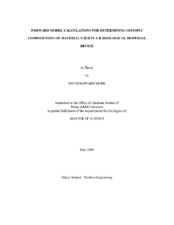| dc.description.abstract | In the event that a radiological dispersal device (RDD) is detonated in the U.S. or
near U.S. interests overseas, it will be crucial that the actors involved in the event can be
identified quickly. If irradiated nuclear fuel is used as the dispersion material for the
RDD, it will be beneficial for law enforcement officials to quickly identify where the
irradiated nuclear fuel originated. One signature which may lead to the identification of
the spent fuel origin is the isotopic composition of the RDD debris.
The objective of this research was to benchmark a forward model methodology
for predicting isotopic composition of spent nuclear fuel used in an RDD while at the
same time optimizing the fidelity of the model to reduce computational time. The code
used in this study was Monteburns-2.0. Monteburns is a Monte Carlo based neutronic
code utilizing both MCNP and ORIGEN. The size of the burnup step used in
Monteburns was tested and found to converge at a value of 3,000 MWd/MTU per step.
To ensure a conservative answer, 2,500 MWd/MTU per step was used for the
benchmarking process. The model fidelity ranged from the following: 2-dimensional pin
cell, multiple radial-region pin cell, modified pin cell, 2D assembly, and 3D assembly.
The results showed that while the multi-region pin cell gave the highest level of
accuracy, the difference in uncertainty between it and the 2D pin cell (0.07% for 235U)
did not warrant the additional computational time required. The computational time for
the multiple radial-region pin cell was 7 times that of the 2D pin cell. For this reason, the
2D pin cell was used to benchmark the isotopics with data from other reactors.
The reactors from which the methodology was benchmarked were Calvert Cliffs
Unit #1, Takahama Unit #3, and Trino Vercelles. Calvert Cliffs is a pressurized water
reactor (PWR) using Combustion Engineering 14??14 assemblies. Takahama is a PWR
using Mitsubishi Heavy Industries 17??17 assemblies. Trino Vercelles is a PWR using
non-standard lattice assemblies. The measured isotopic concentrations from all three of
the reactors showed good agreement with the calculated values. | en |


